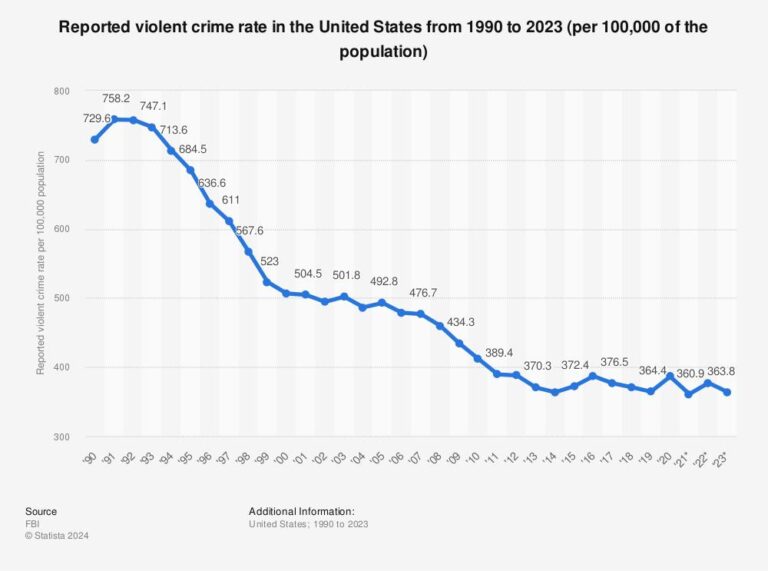Violent crime rates are plunging across the United States, marking a significant shift in the nation’s recent public safety landscape. According to the latest analyses from law enforcement agencies and independent researchers, key indicators of violent offenses—including homicides, assaults, and robberies—have seen substantial declines in numerous cities and states. This downward trend challenges long-standing perceptions of escalating violence and raises important questions about the factors driving this transformation. In this article, we explore the data behind the drop in violent crime, examine its implications, and consider what this means for the future of American society.
Violent Crime Trends Reveal Significant Decline Nationwide
Recent data reflects a marked downturn in violent offenses, with law enforcement agencies reporting consistent decreases in major crimes such as homicide, robbery, and aggravated assault. This trend is not isolated but spans across urban and rural communities alike, signaling a nationwide improvement in public safety. Experts attribute this decline to a combination of improved policing strategies, community engagement initiatives, and advances in technology that aid crime prevention and resolution.
Key factors driving the reduction include:
- Enhanced use of data analytics for targeted interventions
- Expanded social programs addressing root causes of violence
- Collaborative partnerships between law enforcement and local communities
- Increased investment in mental health resources
| Crime Type | 2020 Rate (per 100,000) | 2023 Rate (per 100,000) | % Change |
|---|---|---|---|
| Homicide | 6.0 | 4.3 | -28% |
| Robbery | 81.0 | 55.2 | -32% |
| Aggravated Assault | 250.1 | 187.7 | -25% |
Underlying Factors Driving the Drop in Violent Offenses
Several core elements have converged to drive the significant decline in violent offenses across the United States. Improvements in policing strategies, including the expansion of community engagement programs and data-driven crime analytics, have enabled law enforcement agencies to proactively prevent incidents before they escalate. Additionally, economic recovery in many urban areas has contributed to fewer opportunities and motivations for violent acts, as stable employment and improved social services create safer environments.
Other crucial contributors include:
- Advancements in technology: Enhanced surveillance and communication tools have improved response times and deterrence.
- Demographic shifts: An aging population correlates with a natural decline in crime rates.
- Focused criminal justice reforms: Policies aimed at rehabilitation and reducing recidivism have had positive effects.
| Factor | Impact on Crime Rate |
|---|---|
| Community Policing | Significant reduction |
| Economic Growth | Moderate reduction |
| Technological Advances | Steady decrease |
| Demographic Changes | Gradual decline |
Impact of Community Policing and Technological Advances
The decline in violent crime rates across America is closely intertwined with the evolution of community policing strategies and the integration of cutting-edge technology. Police departments nationwide have increasingly embraced community-oriented approaches, fostering stronger relationships between officers and residents. This trust-building has led to more effective crime prevention and a greater willingness for community members to cooperate with law enforcement. Key components contributing to this success include:
- Neighborhood Engagement: Regular interaction and open communication between officers and the community to identify and address local issues.
- Problem-Oriented Policing: Targeted interventions focusing on specific crime hotspots rather than broad punitive measures.
- Collaborative Partnerships: Joint efforts with local organizations and social services to tackle underlying causes of crime, such as poverty and addiction.
Concurrently, technological innovation has revolutionized policing efficacy, allowing for quicker responses and enhanced investigative capabilities. Sophisticated surveillance systems, predictive analytics, and real-time data sharing among agencies have transformed how law enforcement tackles violent crime. The table below highlights the impact of select technologies on crime reduction:
| Technology | Main Benefit | Crime Reduction Contribution |
|---|---|---|
| Body-Worn Cameras | Improves accountability | 15% decrease in use-of-force incidents |
| ShotSpotter | Real-time gunfire detection | Faster response times by 30% |
| Predictive Policing | Crime hotspot forecasting | 20% drop in violent crime in targeted areas |
Policy Recommendations for Sustaining Crime Reduction Efforts
To ensure the momentum of declining violent crime rates is maintained, policymakers must focus on a multi-faceted approach that integrates community engagement, data-driven policing, and socioeconomic investment. Prioritizing transparency and accountability in law enforcement will build public trust, making collaboration between police departments and communities more effective. Meanwhile, adopting advanced analytics helps target resources strategically, enabling quicker response to emerging crime trends without compromising civil liberties.
Investment in education, mental health services, and job creation remains indispensable for long-term crime reduction. Below is a concise summary of essential policy interventions:
- Community Policing: Strengthening neighborhood partnerships to foster mutual trust.
- Smart Resource Allocation: Utilizing crime data to deploy officers efficiently.
- Social Programs: Expanding access to mental health and youth outreach services.
- Economic Support: Job initiatives targeting at-risk populations.
| Policy Area | Key Action | Expected Outcome |
|---|---|---|
| Law Enforcement | Accountability & Transparency | Increased public trust |
| Technology | Crime Data Analytics | Efficient resource use |
| Social Services | Expanded Mental Health Access | Reduced recidivism |
| Economic Development | Job Training Programs | Lower crime drivers |
In Conclusion
As the United States experiences a significant decline in violent crime, experts urge continued investment in community policing, social programs, and economic development to sustain this positive trend. While challenges remain, the data underscores a pivotal shift in public safety, offering policymakers and citizens alike a cautiously optimistic outlook for the future. The evolving landscape of crime in America invites further scrutiny and action to ensure these gains translate into lasting improvements for all communities.




